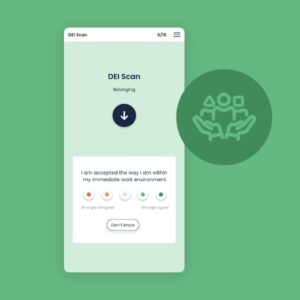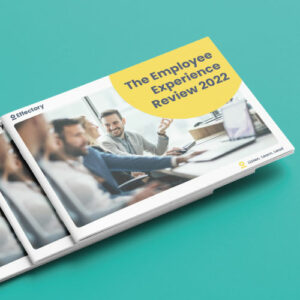Diversity and inclusion have been hot topics for over half a decade already, but organizations implementing it in meaningful ways remains a challenge.
How to measure employee inclusion

The acronym DE&I may be popular, but what does it mean? There is still some confusion over what the letters refer to, how they’re distinct, and how you can use employee listening and employee feedback to improve DE&I in your organization.
What does DE&I mean?
In our experience, diversity and inclusion are often confused. People sometimes think that they’re the same concept, but they actually refer to two distinct things. According to leading inclusion strategist Ruchika Tulshyan, diversity refers to “seeking the equal or greater representation of underrepresented, historically marginalized people.”
Meanwhile, inclusion refers to “the actions taken to represent, welcome and value people from historically underestimated, marginalized communities.” As VP of Inclusion Strategy at Netflix Verna Myers describes it, diversity is being invited to the party and inclusion is being asked to dance.
There is also often confusion between equality and equity. The ‘E’ in DE&I refers to Equity. While equality is about treating everyone the same, equity is about providing people with the support and tools particular to their needs so that everyone has the same opportunities. Tulshyan describes equity within organizations as being about “identifying and dismantling systemic barriers to the representation and inclusion of historically marginalized and underrepresented communities.”
Start Your DEI Scan Today
Assess your organization’s DEI efforts with Effectory’s DEI Scan. Get a clear baseline, actionable data, and a manager’s toolkit to guide your DEI journey.
Start your DEI Scan todayWhy business is thinking about DE&I
According to research at the University of California, Berkley, working alongside people from different backgrounds makes us smarter, more innovative, and hardworking. There is also an ethical aspect to DE&I. Organizations should represent the communities they’re based in. DE&I came out of efforts to correct historical discrimination against minority and marginalized groups, and companies and non-profits need to play their part in this process.
There is also a business case for working on diversity and inclusion. Research by the World Economic Forum shows that “companies with above-average diversity scores drive 45% average revenue from innovation, while companies with below-average diversity scores drive only 26%.”
DE&I has become a major part of HR’s role. In 2020, the number of HR leaders identifying DEI efforts as a top priority was 1.8 times higher than it was in 2019. The same period also saw an 800% increase in job postings for dedicated diversity recruiters.
Although HR drives a lot of DE&I initiatives, it’s an organization’s leadership that needs to be front and center of efforts to improve DE&I. If there is no proper leadership on this topic, there won’t be the resources or the time dedicated necessary to improving on it.
The importance of inclusion in organizations: Its impact on Retention and Employee Net Promoter Score (eNPS)
We’ve looked at the feedback of 75,000 employees given across all industries in 2022 to discover what themes and trends inclusion is closely tied to.
Two interesting correlations we found are between how inclusive employees rate their organizations and how likely they are to give them a high score on other important metrics.
Organizations which are more inclusive are less likely to have employees looking for work elsewhere. Employees who rate their organizations low for inclusion are twice as likely to be looking for a new job. DE&I is incredibly important for Millennial and Gen Z employees, who will make up 75% of the workforce by 2025.
An organization’s eNPS is also affected by inclusion. The eNPS, or Employee Net Promoter Score, is a system that helps employers measure employee satisfaction and loyalty within their organizations. Collecting your organization’s eNPS score is a great starting point for understanding how satisfied employees are at work. Important metrics such as engagement and retention are also closely related to an eNPS score.
We discovered that organizations which score highly for inclusion are twice as likely to have satisfied and loyal staff, while organizations which score low on inclusion are three times more likely to have employees being critical of the organization.
How can organizations put DE&I into practice?
It takes awareness, intention, and regular practice to improve inclusion. It starts with examining biased systems and policies that perpetuate inequality and exclusionary behaviors. Inclusion needs to be driven on purpose and intentionally. Organizations need to be able to measure metrics related to DE&I, so that they can track their progress and see what can be improved.
Effectory’s DE&I scan is about breaking down DE&I into measurable parts so that organizations can assess the outcomes of their inclusion policies. Regardless of whether an organization has specific DE&I policies in place, it helps you understand how inclusive your workplace currently is by asking questions on topics that directly impact DE&I. Organizations who have specific DE&I policies in place can also track if their policies are working by analyzing the metrics to these questions multiple survey results.
How to measure Inclusion with an Effectory employee survey
A 2021 survey found that 65% of respondents did not think that their organizations are diverse and inclusive. The same Harvard Business Review survey found that people in 35% of organizations do not talk about organizational culture. This demonstrates that there is still some way to go before organizations are seen to be taking this seriously.
Meanwhile, many organizations have become more diverse, or have implemented diversity training, but they have not necessarily become inclusive at the same time. As one report says, “Companies need a systemic, business-led approach to inclusion and diversity, as well as bolder action on inclusion.”
As we’ve seen, inclusion impacts business, and there is an ethical element to working to be a more inclusive and diverse organization. Despite this, DE&I often remains more of a buzzword and too vague which then demotivates organizations from taking action.
But inclusion can be measured, and improved. Effectory can support you with this with our DE&I scan that asks employees questions on the key topics that impact DE&I.
Effectory’s DE&I scan helps organizations measure this theme by asking employees questions around seven key points:
- Fair treatment
- Integrating differences
- Decision making
- Psychological safety
- Trust
- Belonging
- Diversity
Based on the responses to Effectory’s DE&I survey, organizations can assess what impact their DE&I policies are having. They can track their performance over time and can also compare results to geographical and industry benchmarks.
Download the Employee Experience Review
Discover how employees around the world are experiencing different parts of the employee journey and how this affects the employee experience.
DownloadEmployee sentiment trends on Inclusion from 2022
Here’s some highlights from our research into employee feedback and inclusion trends in 2022.
Studying our most recent data, we’ve uncovered the three main predictors of employees rating their workplaces as inclusive.
These are:
Psychological Safety
An organization’s score on psychological safety shows the degree to which its employees are comfortable sharing their opinions with their colleagues and managers, and whether giving and receiving feedback is encouraged.
Teamwork
Teamwork refers to how collaborative a team is in order to achieve shared goals. High scores on teamwork illustrate the collegiality, cooperation, and cohesiveness of a team. Such teams are more likely to be positive about working together and perform better than teams with low scores on teamwork.
Trust
Trust is the extent to which employees feel that their colleagues can complete their tasks and behave with integrity. It also involves the degree to which people feel they are trusted by others to perform. Effectory measures trust on three levels: trust in colleagues, trust in management, and received trust from the organization.
We’ve also found that employees who score their employers highly when it comes to acting on employee feedback are 13% more likely to also give their organization a high score when it comes to inclusion.
It’s time to start measuring inclusion in your workplace
We’ve looked at:
- What DE&I means
- The ethical and business case for DE&I
- How DE&I impacts key metrics such as eNPS
- How organizations can measure DE&I with employee surveys
- DE&I trends from 2022
We’ve seen how acting on employee feedback alone make employees rate their organizations highly for inclusion. This is because it’s a great way to amplify the employee voice and take everyone’s opinions and ideas into account.
DE&I will only continue to become more important, especially as workforces around the world become more diverse. Organizations that take DE&I seriously will not only have a competitive edge in the marketplace, but will also be more appealing workplaces for talent. It’s time to start asking your people about DE&I in your organization – and take concrete steps to make everyone feel welcome, safe and valued in the workplace.
Book a free demo. See our solutions in action.
Effectory is Europe’s Leading provider of Employee Listening Solutions. Schedule a product demo and discover how to enhance your employees’ engagement.
Demo request

